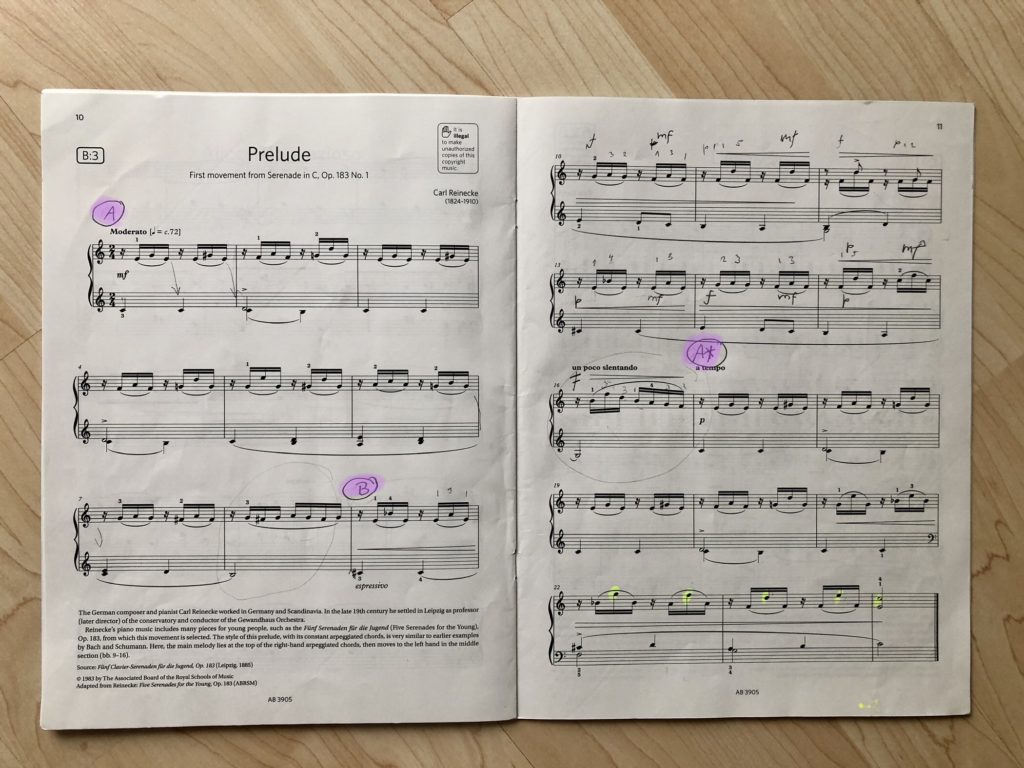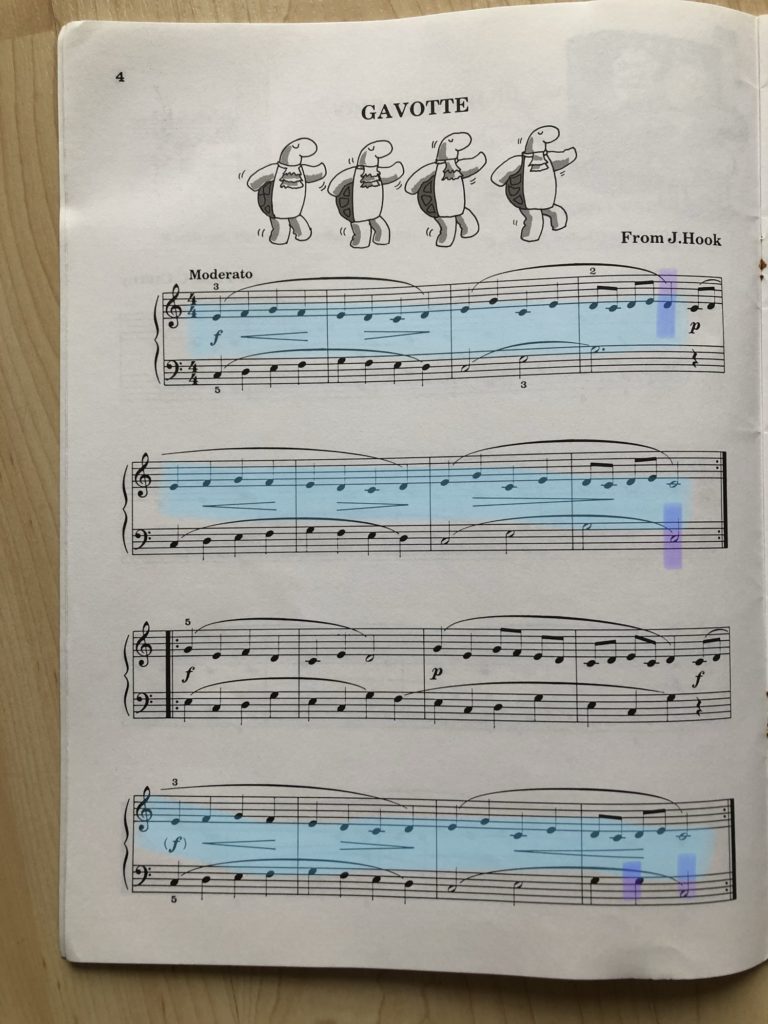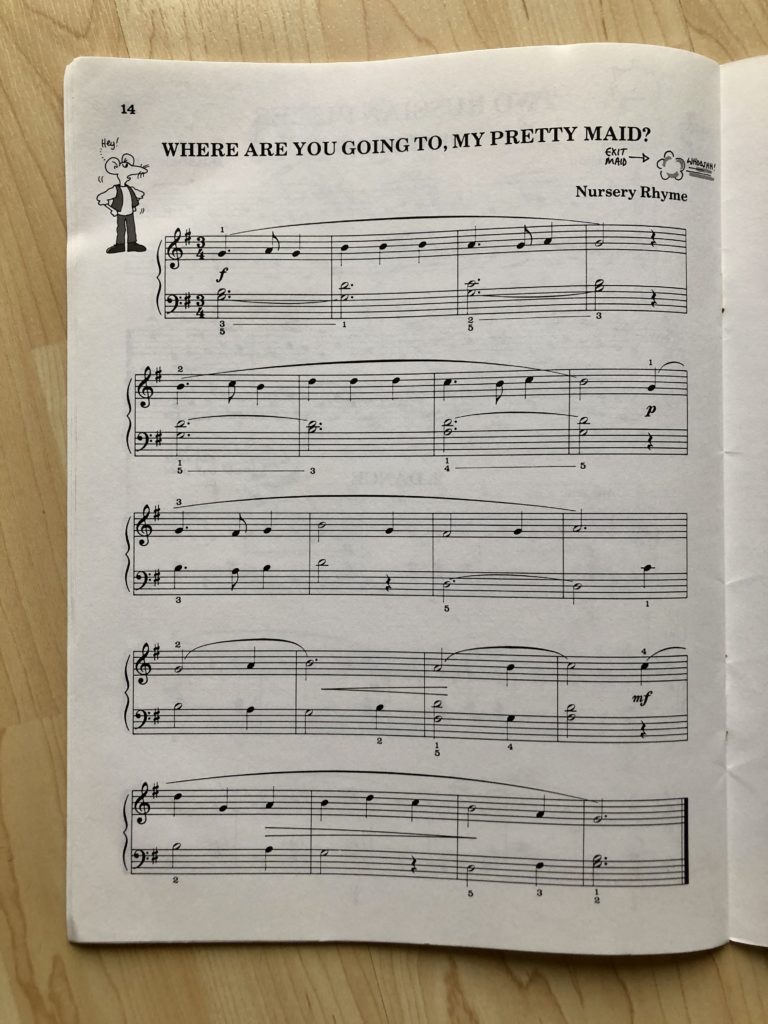When I was a child I believed that the longer I practice; the better I play. I wish someone had explained how to practice piano pieces more effectively back these days as I have wasted an unhealthy amount of time by practising inefficiently. I am not saying that the length of practising is not essential, but it is vital to consider other, significant factors to get the most out of your practising:
1. Make sure you Play Correct and Consistent Fingers
When it comes to practising the piano, one of the most common mistakes is playing with inconsistent fingers. If you are new to piano playing, always ensure you are clear about what fingers you are going to play where. I always encourage students to write finger numbers down, especially when it comes to more difficult parts of pieces and chords.
Setting up the right fingers from the beginning is as important as playing in phrases (see tip no. 3). Missing this tip for correct piano playing could cause some issues. Inconsistent fingers put you at risk of playing with mistakes consistently. This will make it more challenging to get into the flow of a piece.
Playing with consistent fingers will help tremendously with your muscle memory. Inconsistent fingering will cause unnecessary confusion. So grab a pencil and write down the finger numbers; your hands will thank you later.
Extra Tip for Beginners:
Beginners do sometimes have a bad habit of moving hands around the keys a lot when they get into an unconscious “panic” to find the right key. So the basic rule is to keep your hand on the keys, and your wrists with fingers will find a way through if you have written them down.
2. Split the Piece into Smaller Parts
Playing a whole piece over and over again like a carousel while making the same mistakes leads you nowhere as you are not playing consciously. I am not saying you should stop playing the whole piece; instead, you should concentrate on the bits that need more attention. Try splitting the piece into smaller parts and focus on these places where you feel you are not 100% confident.
How to Split the Piece into Smaller Parts Correctly
You may wonder how to split the piece into smaller parts. If you are a beginner; let your teacher help you so that phrases in the pieces aren’t disrupted. Try to break down the work in a way that makes sense as though you are creating miniature songs which fit together nicely.
I usually split parts into A, B, C, etc (or 1,2,3…). If you get a part which is similar to the existing part, then I make it the same letter with an added star* on top as per below image:

Examples of What to Look at when Splitting the Piece into Smaller Parts
Changes in the Tempo (e.g. slowing down)

Repeated Parts (repeat bar line) and Repeated Phrases
Repeated Parts
The below piece called Gavotte could be split into 2 main parts:
- First two lines as per repeat bar line
- Last two lines as per repeat bar line
Repeated Phrases
The blue highlighted lines are highlighting repeated phrases on top so the piece is very easy to play>

Key Change
The first page is in C major, whereas 2nd page moves into C minor. The piece could be also easily split onto 4 sub-parts following repeated bar lines.

3. Play in Phrases
Do you remember how you learnt reading as a child? You started with recognising letters in the alphabet which would make little sense on their own, then whole words thereafter and finally whole sentences. It is the same with music. Notes alone will make no sense, but looking at them as a group will help you understand phrases and then the whole of any piece you play.
Playing music is like reading a book; notes are letters which come together into the words, and these then become whole phrases. Let’s start with a simple example; Twinkle, Twinkle little star. If you learn the song this is a way you may practise it using phrases:
- Twinkle, Twinkle Little Star (phrase 1)
- How I Wonder what you Are (phrase 2)
- Up above the Sky so High (phrase 3)
- Like a Diamond in the Sky (phrase 4)
Working with rhymes is the easiest way to begin an understanding of musical phrasing. If you learn a new verse as a child, you wouldn’t start word by word. You’d begin phrase by phrase. The process should be the same when learning a new piece, so my tip is to look for slurs/phrases which will guide you through like in the song below:

Power of Slurs
Phrases are usually marked with those long slurs above notes to help you with the understanding of the musical sequence (be careful not to misplace slur phrases with ties or short slurs which serve a different purpose). If you are playing a piece of music where no phrase is marked, you can create them on your own or with the help of your teacher. Here are a couple of questions
I ask myself when getting through a new, unknown melody:
- Where does the melody phrase start, and where does it end?
- If the piece would be sung, how would you sing it?
- Where would you breathe in and breathe out to begin and finish each phrase?
As mentioned above, the purpose of longer slurs is to highlight phrases. Playing in phrases means creating meaningful music, and it will help you to learn the music faster.
Extra Tip for Beginners:
If you are not sure how to find the beginning or endings of musical phrases, start with playing songs you like to sing that you know. Here is a simple exercise that I do with beginners; we clap along with and sing songs they know. If you have a piano teacher, discuss the phrases with them.
4. Set the Right Tempo
One of the most common issues beginners face when playing a new piece is that they fly through the parts they know and get stuck on parts that they aren’t as familiar with. There is some false belief that they should play at the full tempo as they start learning a new piece. This is not sustainable or effective. I always say “pick the tempo you feel comfortable with“. If you are driving a car for the first time, you are not going to drive at 120mph during your first few lessons; it is the same when it comes to playing the piano.
Playing at a slower tempo when learning a new piece is a great help to make sure you have things under control; including your fingers (see tip no.1). There is nothing more important than being completely aware of what you are doing. Mastering faster tempos means you are conscious of what your hands are doing at all times. You strengthen this awareness of what your hands are doing at a slower tempo first, and then gradually pick up the pace.
5. Feel the Beats
Another crucial thing when it comes to practising is rhythm. Make sure you are clear what the rhythm is. You should be able to clap along to the piece you play smoothly.
Extra Tip for Beginners:
When my students clap the music I always ask them to count aloud as well. I find this to be a great help as they hear and control the beats much better than simply clapping without counting. Try it for yourself.

Pingback: Learning Piano with an App: 3 Important Things you should be aware of
Pingback: How to enjoy playing the piano: 3 helpful tips
Pingback: Tempo in music and the great power of slowing down